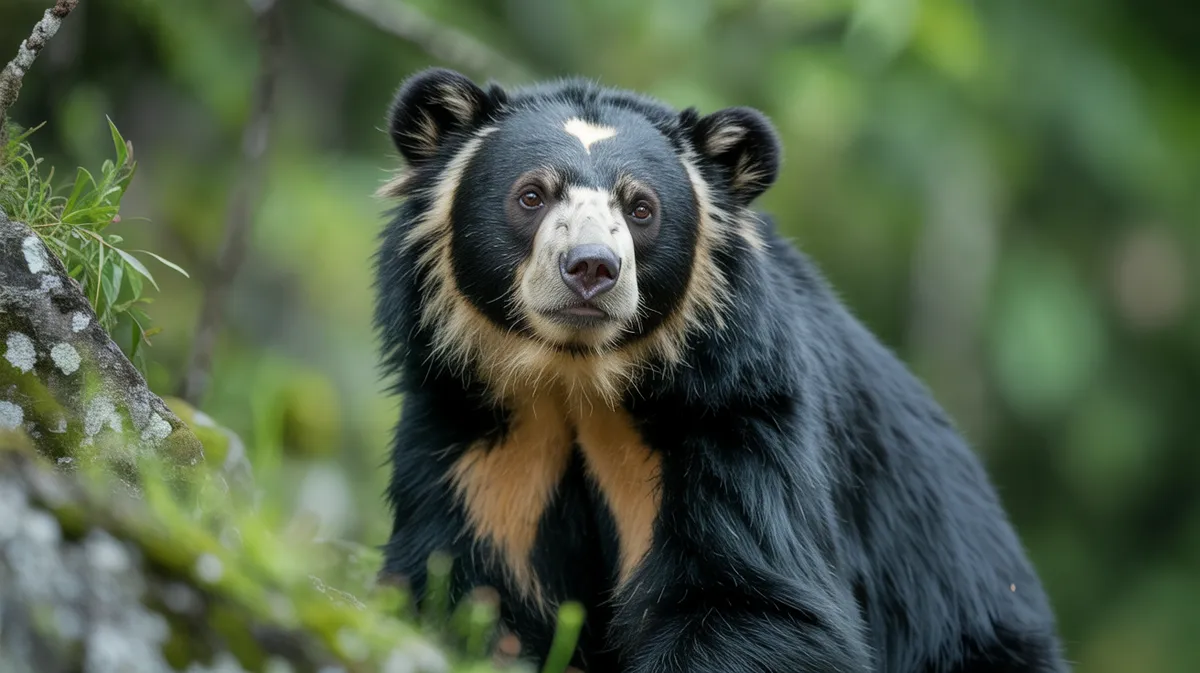
Spectacled Bear
Tremarctos ornatus
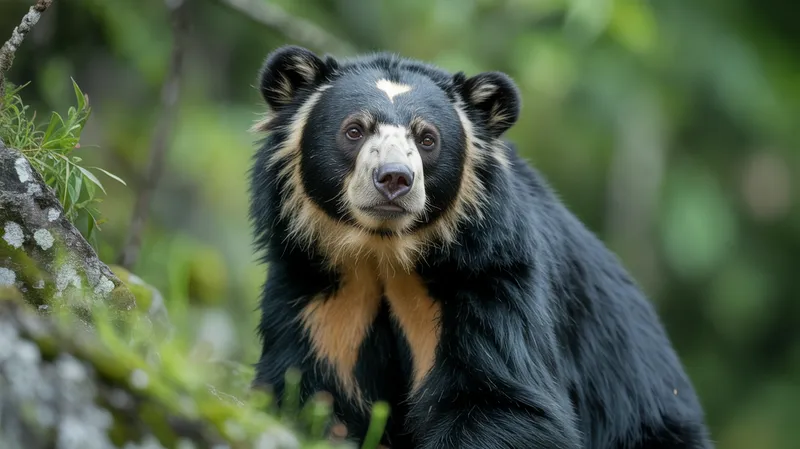
Meet the Spectacled Bear
The Spectacled Bear, also known as the Andean bear, is the only bear species native to South America. Distinguished by the unique, pale markings around its eyes that resemble glasses, each individual's facial pattern is unique. This medium-sized bear is generally shy and elusive, inhabiting dense cloud forests and high-altitude Andean regions. Its omnivorous diet and arboreal habits allow it to thrive in diverse habitats, though it faces significant threats from habitat loss and fragmentation.
Classification
Mammal
Habitat
Cloud forests and Andean mountain forests
Diet
Omnivore
Lifespan
20-25 years
Conservation
Vulnerable
Weight
60–175 kg (130–385 lbs)
📖Fascinating Facts
Unique Markings
The pale 'spectacle' markings around the eyes are unique to each bear and give the species its common name.
Arboreal Lifestyle
Spectacled Bears spend a significant amount of time in trees, where they build platforms to feed, rest, or escape predators.
Plant-Based Diet
Their diet consists primarily of fruits, bromeliads, and other vegetation, but they will also eat insects, small mammals, and carrion when available.
📋Detailed Description
The spectacled bear (Tremarctos ornatus) is a medium-sized bear, with adult males typically weighing between 100–200 kg (220–440 lbs) and females significantly smaller at 35–82 kg (77–181 lbs). Standing up to 1.8 meters (5.9 ft) tall when upright, they have a robust body, short but powerful limbs, and a short tail. Their most distinctive feature is the variable pale or white markings around the eyes and muzzle, which can extend to the chest and give the appearance of 'spectacles'; these markings are unique to each individual. Their dense, shaggy fur is usually black or dark brown, providing insulation in the cool, humid environments of the Andes. Spectacled bears are primarily arboreal among bears, adept climbers that often build platforms in trees for feeding or resting. Solitary by nature, they are elusive and mostly nocturnal or crepuscular, with activity peaks at dawn and dusk. Their home ranges can vary from 7 to over 200 km², depending on habitat quality and food availability. The species is highly adaptable, occupying a range of elevations from 250 to 4,750 meters (820–15,580 ft), including cloud forests, high-altitude grasslands (paramos), and dry forests. Despite being classified as carnivores, their diet is predominantly herbivorous, consisting of fruits, bromeliads, palm nuts, cacti, and occasionally small mammals, birds, or carrion.
💡 Did you know?
Despite being a bear, up to 85% of the Spectacled Bear's diet consists of plant material, making it the most herbivorous living bear species.
🔬Research & Sources
Wikipedia Summary
The spectacled bear, also known as the South American bear, Andean bear, Andean short-faced bear or mountain bear and locally as jukumari, ukumari (Quechua) or ukuku, is a species of bear native to the Andes Mountains in northern and western South America. It is the only living species of bear native to South America, and the last remaining short-faced bear. Unlike other omnivorous bears, the diet of the spectacled bear is mostly herbivorous. The species is classified as Vulnerable by the IUCN because of habitat loss.
Last Modified: 6/2/2025
🎭Behavior & Social Structure
Spectacled bears are solitary, except during mating season or when females are raising cubs. They are primarily crepuscular, foraging during early morning and late afternoon, though activity patterns may shift in response to human disturbance or food availability. They are exceptional climbers, often ascending trees to access fruit or escape threats, and have been observed constructing leafy platforms in the canopy for feeding or resting. Feeding behavior is characterized by dexterous manipulation of food with their forepaws and strong jaws capable of crushing tough plant material. While largely herbivorous, they may opportunistically prey on small animals or scavenge carcasses. Home ranges are marked with scent and claw marks on trees. Social interactions are rare but can include vocalizations, scent marking, and occasional tolerance at abundant food sources. Bears may travel several kilometers daily in search of food, especially during fruiting seasons.
👶Reproduction & Life Cycle
Spectacled bears are polygynous, with mating typically occurring between April and June, though timing may vary regionally. Females exhibit delayed implantation, with actual gestation lasting about 5.5 to 8.5 months, including a diapause period. Cubs are usually born between December and February in secluded dens made in tree hollows, caves, or dense vegetation. Litters consist of 1–3 cubs (most commonly 1 or 2), each weighing 300–330 grams (10–12 oz) at birth. Cubs are altricial, blind, and dependent on maternal care for several months. Weaning occurs at around 3–4 months, but cubs may remain with the mother for up to a year. Females reach sexual maturity at 4–7 years, while males mature slightly later. Parental care is exclusively maternal, with females fiercely protective of their young.
🛡️Adaptations & Survival
Spectacled bears exhibit several adaptations to their Andean environment. Their strong, curved claws and flexible limbs facilitate climbing and foraging in trees. A broad, powerful jaw and specialized molars allow them to process tough, fibrous plant material, such as bromeliads and palm nuts. Their keen sense of smell aids in locating fruit and other food sources. The dense, oily fur provides insulation against the cool, wet conditions of cloud forests. Behavioral flexibility, including shifts in activity patterns and diet, enables them to exploit a wide range of habitats and seasonal food resources. Delayed implantation in reproduction allows females to time births with optimal food availability.
📚Research Sources
🎨Cultural Significance
The spectacled bear holds significant cultural importance in Andean societies. In Quechua and Aymara mythology, the bear is often seen as a symbol of strength, wisdom, and connection between the natural and spiritual worlds. Known locally as 'jukumari', 'ukumari', or 'ukuku', the bear features in traditional stories and festivals, such as the 'Ukukus' dancers in Peru's Qoyllur Rit'i festival, where performers dressed as bears mediate between humans and mountain spirits. Historically, some indigenous groups attributed medicinal or spiritual properties to bear parts, though such uses are now rare and discouraged.
🔬Recent Research & Discoveries
Recent research has focused on the genetic diversity and population structure of spectacled bears, revealing significant genetic differentiation between northern and southern populations, which has implications for conservation management. Camera trap studies and GPS collaring have improved understanding of habitat use, movement patterns, and responses to habitat fragmentation. Dietary studies using stable isotope analysis confirm the predominance of plant material in their diet and highlight seasonal shifts in food preferences. Ongoing research is investigating the impacts of climate change on Andean habitats and the effectiveness of wildlife corridors in maintaining genetic connectivity. Citizen science and community-based monitoring programs are increasingly important for data collection and conservation outreach.
🎥Wildlife Videos

The Secret life of Spectacled Bear | SLICE WILD | FULL DOC
The spectacled bear, the most mysterious plantigrade on the planet, lives on the high plateaus of the Andes. For the first time, ...
SLICE Wild
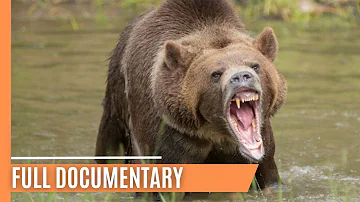
Inside the World of Bears | Full Documentary
Venture into the wild to meet the amazing Bear family … some of the largest, strongest mammals roaming the planet.
Free High-Quality Documentaries

Conserving Machu Picchu's Spectacled Bears and Other Natural Treasures
Watch to learn more about SBC's long-term goal in collaboration with the Peruvian government and local communities to create a ...
Spectacled Bear Conservation

Spectacled Bears: The Apex Predator of The Andes
----------- SOCIAL MEDIA https://www.tiktok.com/@animalogic https://www.instagram.com/animalogicshow/ ...
Animalogic
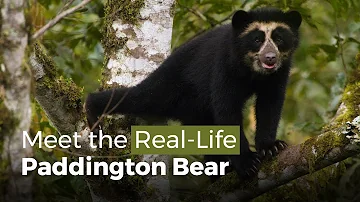
Meet the Real-Life Paddington Bear
“Bears“ premieres Wednesday, November 20 at 8|7c on PBS --------------- For full NATURE episodes, check out ...
Nature on PBS
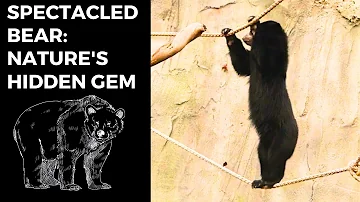
Spectacled Bear: Nature's Hidden Gem
The Spectacled Bear, also known as the 'Andean Bear, This elusive creature holds the title of being the only bear species native ...
Familiarity With Animals (FWA)
🌍Habitat Information
The Spectacled Bear typically inhabits Cloud forests and Andean mountain forests environments. Spectacled Bears have adapted to their environments with specialized features and behaviors.
Primary Habitat:
Cloud forests and Andean mountain forests
More detailed habitat information will be available soon.
🛡️Conservation Status
The Spectacled Bear is currently classified as Vulnerable. Conservation efforts are crucial for preserving this species for future generations.
Common Threats:
- 🏠Habitat loss and fragmentation
- 🌡️Climate change impacts
- 🎯Hunting and poaching
- 🏭Human-wildlife conflict
⚠️Threats & Conservation Challenges
The primary threats to spectacled bears are habitat loss, fragmentation, and degradation due to agricultural expansion, cattle ranching, mining, and infrastructure development. Human-bear conflict arises when bears raid crops or livestock, often resulting in retaliatory killings. Illegal hunting for body parts and the pet trade also pose risks. Climate change threatens to alter Andean ecosystems, potentially reducing suitable habitat. Population estimates are uncertain but suggest fewer than 10,000 mature individuals remain, with declining trends in many areas. Conservation challenges include limited protected area coverage, lack of connectivity between populations, and insufficient enforcement of wildlife laws.
🔬Scientific Classification
Scientific Name
Tremarctos ornatus
Classification Hierarchy
🔍 About Taxonomic Classification
Taxonomic classification is a hierarchical system used by scientists to classify and organize living organisms based on shared characteristics and evolutionary relationships.
The system moves from broad categories (Kingdom) to increasingly specific ones, with each animal's scientific name typically consisting of its Genus and species.
📝Community Notes
Share your observations and insights about the Spectacled Bear with our community of wildlife enthusiasts.
Join Our Community
Sign in to share your observations and connect with fellow wildlife enthusiasts.
Sign In to ContributeNo community notes yet
Be the first to share your observations about the Spectacled Bear!
Explore Spectacled Bear
Select a tab above to learn more about this amazing animal.
📸Photo Gallery
No photos available for this animal yet.
🌟Discover More Wildlife
Continue your journey of discovery with more fascinating animals from our database
